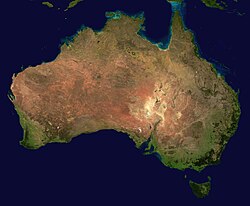
Back جغرافيا أستراليا Arabic Xeografía d'Australia AST Avstraliya coğrafiyası AZ География на Австралия Bulgarian ऑस्ट्रेलिया के भूगोल BH অস্ট্রেলিয়ার ভূগোল Bengali/Bangla Geografia d'Austràlia Catalan Geografie Austrálie Czech Geographie Australiens German Γεωγραφία της Αυστραλίας Greek
 | |
| Continent | Oceania (continent) |
|---|---|
| Region | Oceania |
| Coordinates | 27°00′00″S 144°00′00″E / 27.000°S 144.000°E |
| Area | Ranked 6th |
| • Total | 7,688,287[1] km2 (2,968,464 sq mi) |
| • Land | 98.21% |
| • Water | 1.79% |
| Coastline | 59,681 km (37,084 mi) |
| Borders | None |
| Highest point | Mount Kosciuszko 2,228 m (7,310 ft) |
| Lowest point | Lake Eyre, −15 m (−49 ft) |
| Longest river | Murray River, 2,375 km (1,476 mi) |
| Largest lake | Lake Eyre 9,500 km2 (3,668 sq mi) |
| Climate | Mostly desert or semi-arid, south-east and south-west corners: temperate, north: tropical climate, varied between tropical rainforests, grasslands, part desert, mountainous areas: subantarctic tundra |
| Terrain | Mostly low plateau with deserts, rangelands and a fertile plain in the southeast; mountain ranges in the east and south-east. |
| Natural resources | Minerals, coal, and timber |
| Natural hazards | Cyclones along the northern coasts, severe thunderstorms, droughts, occasional floods, heat waves, and frequent bushfires |
| Exclusive economic zone | 8,148,250 km2 (3,146,060 sq mi) |
The geography of Australia encompasses a wide variety of biogeographic regions being the world's smallest continent, while comprising the territory of the sixth-largest country in the world. The population of Australia is concentrated along the eastern and south-eastern coasts. The geography of the continent is extremely diverse, ranging from the snow-capped mountains of the Australian Alps and Tasmania to large deserts, tropical and temperate forests, grasslands, heathlands and woodlands.
The countries that govern nearby regions include Indonesia, East Timor, and Papua New Guinea to the north; the Solomon Islands, Vanuatu, and the French dependency of New Caledonia to the east; and New Zealand to the southeast.
- ^ "Area of Australia - States and Territories". 27 June 2014.